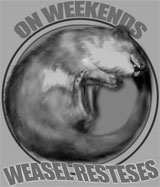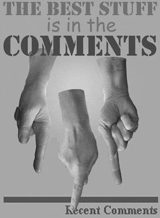Awwww. Sorry, Norman
 We went to London Saturday. No, no…we didn’t meet up with the Socialist Rent-a-mob, we went to a Norman Rockwell exhibit at the excellent Dulwich Gallery. First time Rockwell has been shown over here.
We went to London Saturday. No, no…we didn’t meet up with the Socialist Rent-a-mob, we went to a Norman Rockwell exhibit at the excellent Dulwich Gallery. First time Rockwell has been shown over here.
The critics here (who probably thought Tracy Emin’s Bed was geeenius) greeted the show with predictable sniffy put-downery. For them art, like medicine, doesn’t work unless there’s something bitterly unpleasant about it.
And the public? It was the Dulwich’s most popular show ever. They sold out of show catalogs two weeks before the end.
I’d never seen a Rockwell original. I was prepared to be disappointed. Rockwell relied heavily on carefully posed photographs and I hate illustration that leans too hard on photo reference — because I had to do a huge amount of that in my career (hey, I worked for an engineering company. Accuracy outweighed my artistic pretensions every…single…time).
It has a certain look. Tracing a photo and making the result look artistic is a totally different mental process than staring at something then turning away and trying to rebuild it on paper. The latter is harder work and almost always results in something more interesting to look at.
Anyhow, I was wrong. Totally, totally wrong. Norman Rockwell was a superb painter. His canvases — particularly the early ones — had a Dutch masters quality, with thick, creamy impasto and beautiful finish. Most were big — bigger than I expected — but he worked in many sizes. And there were plenty of loose, painterly studies. And some beautiful pencil drawings!
How he did thousands of paintings (over 4,000 — 323 Post covers alone) in that quality at that size with that much preliminary work…honestly, I do not know. As a matter of personal taste, I could wish he dialed down the schmaltz just a pinch, but as a matter of painterly chops, dude was a genius.
Turns out, the most reproduced artist EVER really doesn’t reproduce all that well.
Posted: March 28th, 2011 under personal.
Comments: 42
Comments
Comment from S. Weasel
Time: March 28, 2011, 10:57 pm
I searched the whooooole interweb for a larger version of this painting here. It was stunning — a big convas, and the shaft of light was startling. According to the label, it’s one of Rockwell’s few paintings that was never used for anything (hence the lack of reproductions, I guess). Same sized color version here.
I just did the math. If Rockwell started when he was 14 (the year he went to art school), he’d have to do 57 paintings a year to reach 4,000. Holy god.
Comment from Nina
Time: March 28, 2011, 11:01 pm
Me, I like the schmaltz. 🙂
Comment from Christopher Taylor
Time: March 28, 2011, 11:25 pm
Its been my experience that most artists are significantly, astoundingly better in the original in person than in prints or photos. The exception are the super minimalist abstract and non representational artists like Kadinsky, their stuff is crap in person, too.
Comment from S. Weasel
Time: March 28, 2011, 11:29 pm
I don’t mind schmaltz, Nina, but he maximized it just a hair beyond my schaltz requirements. The effect of several rooms covered in it was a little vertiginous.
Comment from Cobrakai99
Time: March 28, 2011, 11:32 pm
Having grown up in Upstate NY I was able to go to the Rockwell Museum in his at his studio in Stockbridge, MA. I have always been a fan because of his idealistic paintings of America. This idealism, some theorize, is one of the reasons, along with mainly working as an illustrator, that he consistantly panned by the ‘critics.’
Comment from Mark Matis
Time: March 29, 2011, 12:10 am
Hey, SWeas! You mean you ain’t YET learned that you can’t trust the “critics?” I mean, how do you think “culture” has become what it is these days? He did his work through the Depression and WWII, which probably drove a fair amount of the “schmaltz”. In addition, he undoubtedly realized that would stick in the craw of his critics, so he may have added some for them as well.
All in all, he tried to emphasize what is the best of America, setting a standard for people to aspire to. If you’re gonna do that, schmaltz is a good carrier.
Comment from Randy Rager
Time: March 29, 2011, 12:19 am
Critics, by and large, wouldn’t know anything good if it bit them square in the ass.
Few people realize that Rockwell was a pure genius with the camera, too. But that’s not surprising. Good photos and good paintings both have many of the same qualities.
Comment from Uncle Badger
Time: March 29, 2011, 12:27 am
Because the Dulwich had sold out of catalogues, I ventured onto the interwebs in search of one on Fleabay (‘yours for only $2,000!’) but couldn’t help stepping in some of the messes made by the professional critics, along the way.
Leaving aside that preposterous old pseud, Brian Sewell, even the American, Richard Dormant (who really ought to know better), writing in the Telegraph, managed to commit the most juvenile journalistic error by starting his silly little piece with the assertion that Rockwell’s work was not art!
Not art, eh, Dorment? Well, that’s quite a stake to put in the ground at the head of a mere 1,000 word or so article. So now perhaps you’d pen us a few hundred thousand words more, explaining what art is to justify that opinion? Otherwise, I might be tempted to think you’re just deliberately goosing the readership for a cheap thrill.
And when you’ve done that, perhaps we can get down to you explaining just what it is about Rockwell’s technique you don’t understand. Even better, Richard! Golly gee whiz Moses (to stay with our Rockwell theme) maybe you could actually show us?!
And yes, I do know Johnson’s quote about criticism. But if you are getting down with the cabinet makers to argue about the respective merits of their dovetail joints, it might be of use if you could show us that you can make one yourself. Otherwise, best stick to dissing their choice of veneers.
I’m not trying to play the ‘I may not know much about art…’ game here. But when critics write highly remunerated rubbish (‘painted mostly middle class subjects’ – Rockwell mostly painted working class subjects – ‘never criticised his employer or AmeriKKKa’ – not a great deal of criticism of the Vatican in Michaelangelo, that I’ve noticed either – and so on) I can only conclude that some of these clowns wandered into the gallery with their eyes shut and their minds made up.
No. I don’t think Rockwell was Dou or Rembrandt. Then again, neither do I think the fraud perpetrated on the general public by the art establishment – as represented by self-styled experts – is worth much more than a suitably demotic Bronx cheer.
So Hurrah! for the Dulwich, and its sponsors the WSJ, the US Embassy, Virgin Atlantic as well as the Great British Public, for poking their fingers in the eyes of the art critics.
Clearly, they don’t use them, anyway.
Comment from Can’t hark my cry
Time: March 29, 2011, 12:47 am
Uncle Badger:
Sigh. I haven’t read Johnson, haven’t encountered the quote in question, couldn’t reliably identify it on the Internet, and got tired of searching Bartlett’s after the fifth double-columned page (how electronic searching has spoiled us!). So I humbly beg you’ll share Johnson on criticism. In tribute and in thanks I offer the following, which is actually a bit inapposite here. . .and I find it fascinating to contemplate just why and how it is inapposite.
“PIPLING
Behold a critic, pitched like the castrati,
Imperious youngling, though approaching forty:
He heaps few honors on a living head,
He loves himself, and the illustrious dead;
He pipes, he squeaks, he quivers through his nose.
Some cannot praise him: I am one of those.
Theodore Roethke
Comment from Uncle Badger
Time: March 29, 2011, 1:01 am
It’s a classic, Can’t Hark (though aren’t they all?)
“You may abuse a tragedy, though you cannot write one. You may scold a carpenter who has made you a bad table, though you cannot make a table. It is not your trade to make tables.”
Comment from Can’t hark my cry
Time: March 29, 2011, 1:28 am
Ah! Yup. Thanks!
Mind you. . .I think that even those who can’t create art (me, for one) can have legitimate opinions about what is and is not good art. Which will legitimately differ. But it truly can be tough to mediate between the critically assessing eye and the human awareness of what the creative spirit endures when creating.
Comment from Uncle Badger
Time: March 29, 2011, 2:09 am
I don’t have a problem with critics who choose to take issue with matters of taste or interpretation – but when a critic takes issue with Rockwell’s actual technique, then I think it’s perfectly valid to call him on it.
I might, for example, say I don’t like Emma Kirkby’s interpretation of Sheep May Safely Graze – but if I start picking to pieces the technicalities of her coloratura , it would be nice to have some technical detail to back that up.
Comment from Can’t hark my cry
Time: March 29, 2011, 2:22 am
Oh (best friend of an opera singer says)! Oh, now, that is a remarkably helpful perspective on the whole issue of what is and is not legitimate criticism. Hunh. Thanks.
Comment from Ric Locke
Time: March 29, 2011, 2:34 am
Bah. At some time in the past — half past van Gogh, quarter to Picasso, more or less — somebody made the perfectly true observation that induces in its viewers an alteration in their normal patterns of thought. This quickly became a metric: the more alteration, the more “artistic”. Since the ultimate modification is disruption, and the most effective form of disruption is shock, “Art shocks the senses.”
The problem is twofold: all intentionally inflicted shock or disruption which is not disruptive is slapstick, including the “practical joke”, and human beings have a high adaptability to shock-inducing disruption, the phenomenon of “acclimatization”. In the initial stages, shock is simple and easy — distorting familiar forms was once shocking compared to representation. As people became acclimatized to that source of shock, it was necessary for Art to move on to more violent forms. When Moe tried to poke Larry’s eyes out, it was humor; today it would be Performance Art (and get ten thousand quid of subsidy).
Rockwell’s technique is much more subtle. Yes, it’s schmaltzy, and deliberately so; but as you examine it closely, you see elements that relate to your own life in unexpected (shocking!) ways. Critics accustomed to “Art” at the brick-in-a-hat or gold-coin-epoxied-to-the-pavement level have become so innured to shock that they can’t see anything more subtle than a thrown brickbat, and reject the material as “not art”.
Regards,
Ric
Comment from Ric Locke
Time: March 29, 2011, 2:37 am
Bah. Not using preview is inartistic.
…true observation that art induces in its viewers…
…disruption which is not disruptivedestructive</b is slapstick…
Regards,
Ric
Comment from Wiccapundit
Time: March 29, 2011, 3:01 am
Weas, one of my favorite artists is Don Troiani, who does exquisite military history paintings, particularly of the American War for Southern Independence (Civil War to the unenlightened). As I recall, he once recounted that he was roundly criticized in art school for his traditional approach to art by those who thought the sun rose and set on modern (read: shitty) art. Troiani responded that most modern art looked like a five-year-old drew it, and the reason five-year-olds draw the way they do is because THEY HAVEN’T LEARNED HOW TO DRAW YET.
One of the best touchstones I have is this: if I could reproduce the work, it ain’t art.
Seriously, do you think Saatchi would be willing to buy MY unmade bed? I promise I can make it look as ratty and disgusting as Emin’s “work.”
Comment from Mike C.
Time: March 29, 2011, 8:25 am
Art critics (and especailly modern art critics) – is there a lower form of life in the known universe?
Comment from Mike C.
Time: March 29, 2011, 9:15 am
Wiccapundit,
Try Mort Kunstler…
He did many paintings set very locally to me. I can go stand in the very same vantage point and still see the same background and buildings
My personal favorite…
http://mortkunstler.com/html/store-limited-edition-prints.asp?action=view&ID=45&cat=192
The building behind Jackson is the Red Lion Inn. Pre-Revolutionary. It was for sale years ago and I desperately wanted to buy it, but it was $ 275,000, a sum I could in no way command.
Comment from surly ermine
Time: March 29, 2011, 12:50 pm
A big “Harrumph!” for Uncle Badger!
hmm, Webster doesn’t seem to agree with Brooks, I meant it as show of agreement….damn Hollywood.
had to check the spelling….didn’t want another demerit.
Comment from Deborah
Time: March 29, 2011, 4:15 pm
Critics. I think most of us understand the difference in art, illustration, and advertising. Which is why I would have given anything to have Ralph William Williams paint me as a Breck girl. Because I looked like Margaret, in “Dennis the Menace.”
Comment from Uncle Monkey
Time: March 29, 2011, 6:00 pm
I love surprises at galleries! It usually happens when you’ve seen an artist so many times in print, be it magazines or all those zillions of art history books. Some you can tell there’s “something more” and others seem to be, well, suitable for lithography.
My biggest epiphany of an artist was a Grant Wood exhibit many years ago. You think – yeah, American Gothic – BFD. How many times have you seen that or a variation of it?
Well, I tell you – we stared at that thing for ages. It was amazing. An artist I always saw as stiff and calculated had amazing energy, and some pieces were incredibly pop – some were positively futurist, even foreshadowing comic art.
Comment from Bill (back from Iraq until I go back to Iraq) T
Time: March 29, 2011, 7:13 pm
Art critics (and especailly modern art critics) – is there a lower form of life in the known universe?
Collectively? Congress…
Comment from S. Weasel
Time: March 29, 2011, 7:52 pm
Weird, Deborah. I tried to approve your other comment — the one with the link in it — and the spam bucket wouldn’t let go of it.
The art versus illustration conversation bores me stiff. It’s all the same thing. Obviously, some paintings are high and some low. Some stir deep emotion and others sell cornflakes to snotty seven-year-olds, but it’s all the same thing. All painters face the same picture problems and technical issues. Even the abstract guys have to learn a thing or two about paint and canvas.
No illustrator gets offended by being called an illustrator. “Illustrator” means an artist who can actually draw.
Comment from S. Weasel
Time: March 29, 2011, 8:20 pm
Who can actually draw and gets paid.
Comment from Deborah
Time: March 29, 2011, 8:59 pm
I decided that I had hit Preview instead of Post (I’ve done it before), and closed out the page. The link was to old covers of “The Writer”—simple but lovely graphic illustrations before they changed over to using photographs. I am short on artistic talent, but long on appreciation, so I am in awe of using the barest of lines to convey thought, action, and emotion.
Comment from Scubafreak
Time: March 29, 2011, 9:04 pm
Stoatie, what do you think of Mark E Rogers of Samurai Cat fame? I’ve always liked the work he did in illustrating his rather comic fantasies….
Kind of a Boris Valiejo for cat geeks….
Comment from Tom
Time: March 29, 2011, 9:19 pm
@wiccapundit
“One of the best touchstones I have is this: if I could reproduce the work, it ain’t art.”
There was an image floating around Tumblr not too long ago (http://www.morenewmath.com/69) which says, in case the link doesn’t work: “Modern Art = I could do that + Yeah, but you didn’t”
I’d like to change that to: Modern Art = (I could do that + Yeah, but you didn’t) / Who in God’s name would want to?
Comment from S. Weasel
Time: March 29, 2011, 10:03 pm
Heh. That’s fun, Scoob. I hadn’t seen Samurai Cat before.
I’ve got a deep and serious hate-on for Boris Vallejo, though. He does to human anatomy what a rock tumbler does to pebbles.
Comment from Can’t hark my cry
Time: March 29, 2011, 11:02 pm
Stoaty–Interesting. Your observation about high and low art applies equally to the written word. Only, because the economics of publishing are entirely different from the economics of art collection and reproduction, the distinction between high and low in fiction has become very blurred in recent years. Thank fortune!
Comment from Uncle Badger
Time: March 29, 2011, 11:21 pm
Shuffle over, Deborah, I’m in your team.
I can barely sign my own name, I’m so graphically incompetent.
Huh! the used to award you an MD for that skill.
Take two cliches and call me in the morning.
Comment from Scubafreak
Time: March 29, 2011, 11:33 pm
LOL… I have all 5 books from my younger geek days. They seem to be something of a collectors item now…
Comment from Scubafreak
Time: March 29, 2011, 11:41 pm
Comment from SCOTTtheBADGER
Time: March 30, 2011, 1:59 am
Tom Freeman can swing a paintbrush, as well.
http://ep.yimg.com/ca/I/yhst-85079201727111_2109_98425812
http://ep.yimg.com/ca/I/yhst-85079201727111_2109_1484768
I enjoy historical image paintings, but also quite like “Good Ol’ Norman” as well.
Comment from Sven in Colorado
Time: March 30, 2011, 2:08 am
I grew up in the Colorado version of Rockwell’s world. Sure as shit wasn’t perfect. I recognize so many characters within my own extended family. He captured a bit of English and Scots/Irish American heritage like no other artist. Italian, Scandinavian, Germanic and central European influences is evident in his work. His characters were clear and classically modeled, full of life.
Unlike his contemporaries, Grant Wood and Edward Hopper, Rockwell’s work celebrates the American middle class; core values and belief in American exceptionalism.
Rockwell and Reagan, both in their own simple brilliance, reflected and encouraged that core belief.
Totally off topic….. Who here recalls this early TV serial intro:
“ Out of the clear blue of the Western sky, comes (______ _______)!“
Comment from Sven in Colorado
Time: March 30, 2011, 2:16 am
OOOH!, and then there is the stunning, luscious and sensuous watercolour work of Steve Hanks:
http://www.yousaytoo.com/lovely/steve-hanks-amazing-watercolors/10486
Comment from Mark Matis
Time: March 30, 2011, 2:22 am
For Sven:
Ironman?
Oh, wait – it’s Sky King!
Comment from Can’t hark my cry
Time: March 30, 2011, 2:23 am
Possibly this is out of line, but, well. . .I have some posters for exhibits of Janet Fish’s art, and a couple of years ago there was an exhibit of her stuff at the Southern Vermont Art Center, and it was, um, awesome. She paints images of glass and plastic and cellophane like nobody’s business. I don’t go to a lot of museums and art exhibits because I was dragged to too many of them as a child–but Fish. Well. . .
http://www.janetfish.net/
And, as you say Stoaty–the online image doesn’t even come CLOSE to capturing the actual experience.
Comment from Mark Matis
Time: March 30, 2011, 3:47 pm
Thank you! Thank you very much!
Of course, everyone surely does recognize the source of that…
Comment from Sven in Colorado
Time: March 30, 2011, 8:36 pm
Mark,
Everyone over 50 years of age might be able to recall Sky King and his neice, Penny.
Sky (Kirby Grant) flew his own plane, a twin engine Cessna T50 during the early TV shows. Cessna sales then donated a new model 310B, as the show’s popularity skyrocketed. (pun intended.
The TV show ran from 1951 to 59.
Comment from Oh Hell
Time: April 1, 2011, 2:05 am
Maxfield Parrish – I have an ornately framed print of his, showing wildly colored mountains in the background and two artistically draped people lounging in a marble building. My Father bought it many years ago due to the label on the back.
“Wildlife in Yellowstone National Park”. It was the one picture I made sure I got when my Mother passed away.
I guess that classifies me as hopeless…..











Write a comment
Beware: more than one link in a comment is apt to earn you a trip to the spam filter, where you will remain -- cold, frightened and alone -- until I remember to clean the trap. But, hey, without Akismet, we'd be up to our asses in...well, ass porn, mostly.<< carry me back to ol' virginny